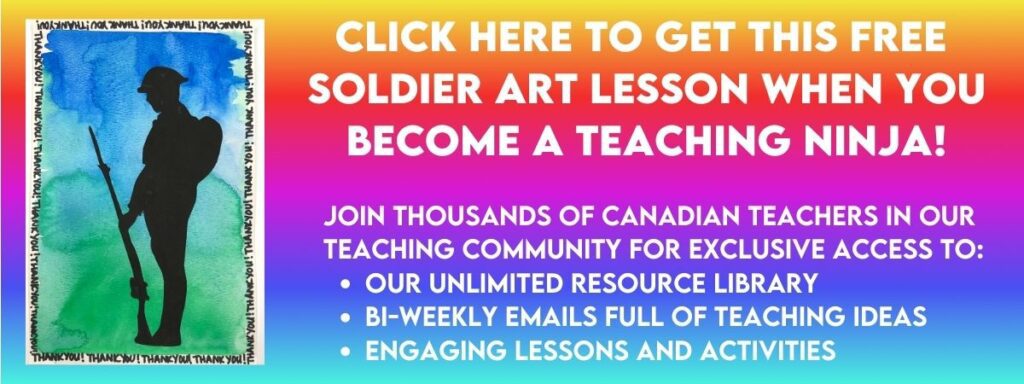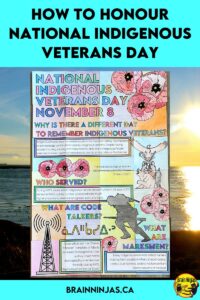
Canadians are aware of observations and ceremonies that honour the service of Canadians in the military. Those who served and died in war are remembered on cenotaphs, named in ceremonies and recognized in military records. But Indigenous Veterans Day is unknown to many Canadians. Only in recent years have Canadians started to recognize the service of those who identify as First Nations, Metis and Inuit and their contributions in the Canadian Armed Forces. It is now recognized on November 8 each year. What does your school or community do to National Indigenous Veterans Day?
Why is there a National Indigenous Veterans Day?
It is important to recognize the valuable contributions of Indigenous People in the service to Canada. They faced language and cultural barriers that English and French Canadian soldiers didn’t have to navigate. In 1994, Manitoba first established Aboriginal Veterans Day (which has been renamed as the term aboriginal is insensitive). November 8 is specifically meant for thanking Indigenous People for their service.
In 2001, the National Aboriginal Monument (name not changed at the time of publication) was erected 2001 in Ottawa, Ontario, Canada. It is full of symbols sacred to Indigenous People and represents the importance of the men and women who fought for the freedom of all Canadians. This free colouring page of the monument is available from the Government of Canada.
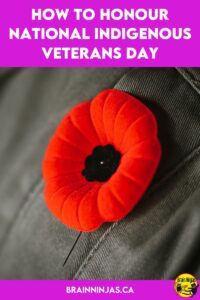
Racism and Indigenous Veterans
Before the First World War, Indigenous and non-Indigenous soldiers rarely interacted. They lived in Canada differently, but during war, they worked together in the trenches. Black Canadians often faced the same type of racism.
“There is no place for racism in the trenches,” is a common statement from that era. Historically Indigenous soldiers weren’t given promotions. They didn’t get the same benefits as non-Indigenous soldiers.
After the war, segregation returned. The marginal treatment of Indigenous People that began before the First World War continued after the war. They gained no social status or better treatment from the Canadian government. Indigenous soldiers were not acknowledged at ceremonies. They were not welcomed into legions across Canada.
Despite earning several medals for bravery, none of their names are familiar to Canadians.
As Canadians slowly learn the impact of colonization, it is this generation’s responsibility to learn the truth about Indigenous veterans and their contribution to history.
How many Indigenous veterans are there?
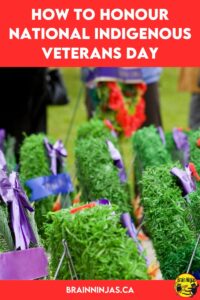
Service records did not always accurately reflect the ethnicity of Indigenous veterans. Some chose to keep their Indigenous roots secret for fear of racism. Others were recorded incorrectly.
Historians have been working to locate the names of Indigenous People who served on behalf of Canada (and countries around the world). Over 6 500 Indigenous People have identified as serving in the Canadian Armed Forces during the First World War and 19 000 have served in conflicts and peacekeeping missions since.
For 200 years, Indigenous People have served Canada. They continue to serve Canada in operations at home and overseas. Today, more than 2 700 Indigenous members continue to serve in Canada’s military forces.
Why were Indigenous veterans valuable?
Many of the skills First Nations, Métis and Inuit use for daily living were valuable for military service. They learned patience when stalking the enemy from hunting. The military valued marksmanship. Hunters became successful snipers. Their tracking skills helped locate enemies. They could easily sneak up on enemies to gather information. Many spoke languages that were foreign to enemies. These languages encrypted communication.
At home in Canada, First Nations, Métis and Inuit used portions of reserve lands to construct airports, build rifle ranges and create defence facilities. First Nations communities in British Columbia, Manitoba and Ontario received the British Empire Medal to acknowledge their contributions. Individuals donated money, clothing and food to causes that supported soldiers and their families.
The sense of community is important to Indigenous People and culture. Despite feeling like outsiders in their own country, they contributed to every aspect of service. Yet, many Canadians are not aware of this service.
How to Honour Indigenous Veterans
Schools hold Remembrance Day ceremonies. Include Indigenous veterans in the event. If there are no Indigenous veterans or service members available, include the stories of the lives of historical Indigenous veterans. Hold a special ceremony or acknowledgement on November 8 (or the preceding school day) specifically to honour Indigenous veterans. This can be as simple as reading an acknowledgement of the day over the intercom and having a moment of silence. We have this post full of Easy Remembrance Day Asembly Ideas.
Students can research Indigenous veterans. They can share details about their service at a ceremony, or publish their findings for others to read. Include biographical details like the name of their First Nation, treaty, family, or other interests.
Students can inform others about Indigenous Veterans Day. A simple way to start is to create this collaborative poster and display it prominently. This poster comes in pieces. Students colour each piece. Reassemble the pieces. Our set includes 18, 24 and 36 pieces. Use it with any size group. Print it two to a page for a small poster or enlarge it for a whole wall. You can find the Indigenous Veterans Day Collaborative Poster in our TpT Store ($USD) or BN Shop ($CAN). We also have a French version in our TpT Store ($USD) or BN Shop ($CAN).
Create artwork that features the silhouettes of Indigenous veterans. Use this lesson plan, but change the silhouette. You can find the free lesson plan in our Resource Library if you are already a ninja. If not, we can send it directly to your inbox when you sign up for our email list. Students can write thank you messages around the painting.
Notable Indigenous Veterans
The best way to honour Indigenous veterans is to learn about them. These mini-biographies are just a hint of information, but they are a good place for students to start.
Charles “Checker” Tomkins
Charles “Checker” Tomkins January 8, 1918 – 2003: He was a Canadian Métis code talker. Code talkers translated messages in Cree, which no other soldiers could speak. They often had to make up new words in Cree since there were no words for war.
He was born in Grouard, Alberta, which is part of Treaty 8. Shortly after marrying Lena Anderson, he enlisted in the armed forces. He served overseas during the Second World War.
Tom Longboat
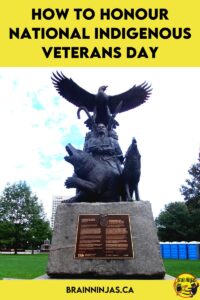
Tom Longboat was born July 4, 1886, in Ohsweken, Six Nations of the Grand River. He was an athlete who specialized in long-distance running. He was the first Indigenous person to win the Boston Marathon, represented Canada at the Olympics and is a member of Canada’s Sports Hall of Fame.
During his youth, he attended the Mohawk Institute Residential School. He ran away from the school regularly and ended up living with his uncle.
In 1916, he enlisted in the Canadian Armed Forces. He served as a messenger which meant running messages over long distances through dangerous territory in France and Belgium. According to false reports, he died in service more than once. He survived the war and returned to Canada.
Charlotte Edith Anderson Monture
Also known as Edith Monture, she was born April 10 1890 on a Six Nations reserve. She was Mohawk, a First World War veteran, and a registered nurse. Edith was the first Indigenous woman to become a registered nurse in Canada. This meant she was one of the first to gain the right to vote in a Canadian federal election. Other Indigenous women did not earn this right until 1960.
Edith was one of the only Indigenous nurses to serve overseas. She thought she would die in the war. Edith returned home before leaving to gather Mohawk burial clothing. She wanted to be buried in it if she died in service.
After the war, she returned home where she continued working as a nurse. She returned to her Six Nations reserve and passed away at the age of 106.
Henry Louis Norwest
Henry Louis Norwest, a Métis born in Fort Saskatchewan, Alberta. This is on Treaty 6 Territory. At the time of his birth in 1884, Alberta was still part of the Northwest Territories.
When the First World War began, Henry was working on a piece of homestead land near Wainwright, Alberta. As winter approached, he decided to enlist in the Canadian Armed Forces. When joined the military in Edmonton, he gave a false name– Henry Louie. He was part of the mounted rifles unit.
It didn’t work out, so he left service and worked with the Royal Northwest Mounted Police.
A year later he re-enlisted under his name. He went overseas to France where he served in the combat unit. Henry was one of the most famous snipers in the entire Canadian Corps. He held a divisional sniping record of 115 fatal shots (though the actual number is believed to be much higher). Norwest was awarded the Military Medal and bar for his courage under fire.
With only months left in the war, Norwest was killed in action by a sniper in Amiens, France.
Tommy Prince
Thomas George Prince was born on October 25, 1915. He was an Ojibwa from Manitoba and was known as Tommy.
Tommy Prince is thought of as an Indigenous war hero. He is one of Canada’s most decorated First Nations soldiers. The Canadian Armed Forces rejected him several times. They finally accepted him during the early years of the Second World War. He quickly worked up through the ranks and became a sergeant with the Canadian Parachute Battalion. This battalion became known as the “Devil’s Brigade” to the enemy. The story of this elite group was even portrayed in a movie.
He volunteered to run communication messages to a farmhouse near the German position. He set up an observation post to communicate the German’s actions back via wire communication. When the wire broke, he pretended to be a farmer by working the land around the farmhouse. He then ran back to the allied forces to report. The Allies destroyed the German encampments.
He returned to Canada after the war, but he was still not allowed to vote. Prince didn’t receive the same benefits non-Indigenous soldiers received. He re-enlisted in the Canadian Armed Forces.
In the Korean war, he served with Princess Patricia’s Canadian Light Infantry. His missions were known as “snatch patrol” raids. They went into enemy camps and capture weapons. Also in Korea, he fought in the Battle of Kapyong in April 1951. The United States Presidential Unit Citation awarded his battalion. It was a rare honour for a non-American force.
Despite his distinguished service, he lived the remainder of his life advocating for changes to the Indian Act. The changes have still not been made. He died in Manitoba in 1977.
Francis Pegahmagabow
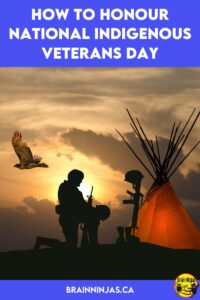
Francis Pegahmagabow was from the Parry Island First Nation in Ontario and was Anishinaabe. He was born on March 8, 1891. He grew up in Shawanaga. Francis learned the cultural customs and traditions of the Anishinaabe. His father passed away from illness and his mother also got sick. Community members raised him. He learned the traditional ways of the Anishinaabe.
The Canadian Armed Forces discouraged Indigenous Peoples and other ethnic minorities from joining the Canadian Armed Forces when the First World War broke out. There were many casualties after the first years of war. The military welcomed all men. Pegahmagabow was one of the first Indigenous soldiers sent overseas.
Known as “Peggy” by his fellow soldiers, he became a sniper, credited with about 378 kills. He would often spend the dark nights in “no man’s land” where he would wait for German soldiers. By the time the war was over, he was one of the most decorated Indigenous soldiers in history.
When he returned to Canada after his service, he received a small pension from the Canadian government. Despite his excellent service, the government didn’t feel he could “handle money well enough” (this was the treatment for most Indigenous People) and so he spent many years in poverty. This frustration led him to become a politician and advocate for Indigenous rights.
Noel Knockwood
Noel Knockwood was born in Sipekne’katik (Indian Brook) First Nation in Shubenacadie, Nova Scotia on July 17, 1932. He was a Residential School survivor. His older brother had served in the Second World War, so he enlisted during the Korean War. During his training, he learned about atomic, biological and chemical warfare. He was just eighteen years old when he went overseas to fight.
After six years of service, he returned to Nova Scotia to continue his education. He became a revered Mi’kmaq Spiritual Elder and won several awards of recognition. From 2000-2005, he served as Sergeant-at-Arms for the province of Nova Scotia. He passed away in 2014.
Other notable names
Many others are worth researching: Cameron Brant, Willard Bolduc, David Greyeyes, Huron Brant, and John Shiwak. This is a list we are continuing to build, so please help us add to our list by commenting below with any names we should add.
The Legacy of Indigenous Service
While it is still unclear exactly how many Indigenous People have served, their stories are important. As we continue on the path of Truth and Reconciliation is it vital that we share all these stories that have been kept quiet through history.
Looking for More Remembrance Day Posts?
- How to Create Memorable Remembrance Day Art Projects
- Simple and Stunning Remembrance Day Art Projects
- Memorable Books for Remembrance Day in Canada
- How to Teach the Importance of Remembrance Day
- Remembrance Day Resources for Canadian Classrooms
- Easy to Use Remembrance Day Assembly Ideas

